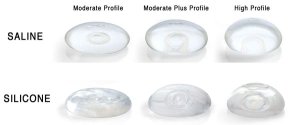An Open Water-student asked this question to her instructor during the course. This was after talking about pressure, decompression, lung expansion and bubbles in a divers blood, and the instructor had just completed the “this-is-what-happens-when-you-take-a-bottle-filled-with-air-down-to-twenty-meters”-skill.
The instructor was a bit overwhelmed by the question, but was quick thinking, and replied; “Well, I guess your implants doesn’t contain air, so I`ll guess you`ll be fine!”
But was he right? Well, kinda.
DAN (Divers Alert Network) was kindly enough to answer some of Pink Divers questions online.
Dr. Richard Vann, Vice President of Research at DAN, says that implants were placed in the Duke University Medical Center hyperbaric chamber. However, the study did not simulate the implant in human tissue, though. Three types were tested: Silicone, saline, and silicone-saline-filled. (Saline implants are silicone shells filled with a sterile saline water, or salt water. Silicone breast implants are filled with a silicone gel.) In this experiment, the researchers simulated various depth/time profiles of recreational scuba diving.
Here’s what they found:
There was an insignificant increase in bubble size (one to four percent) in both saline and silicone gel implants, depending on the depth and duration of the dive. The least volume change occurred in the saline-filled implant, because nitrogen is less soluble in saline than silicone.
The silicone-saline-filled type showed the greatest volume change. Bubble formation in implants led to a small volume increase, which is not likely to damage the implants or surrounding tissue. If gas bubbles do form in the implant, they resolve over time.
REMEMBER! Breast implants filled with saline are neutrally buoyant. Silicone implants are heavier than water, however, and they may alter buoyancy and attitude (trim) in the water, particularly if the implants are large. Appropriate training and appropriate adjustment of weights help overcome these difficulties.
Ok, enough of the medical-talk. We needed some first-hand information on this subject and contacted some diver girls who have breast implants. Patty and Pippi are both instructors and have done around 1800 dives each.
-It`s not the silicone that is the real problem, says Patty. She got 330g x 2 silicone implants.
-But having big boobs, and trying to fit nicely into a BCD, that makes it hard having big boobs!
She had her implants before she got into diving, and asked her doctor for advice.
-He told me he wasn`t really sure, but said that as long as it didn’t hurt or I felt any pain during diving, I should be fine.
-I remember I wanted to ask my instructor, but I was a bit shy so I didn’t… says Pippi.
-But later I asked some of the girls who were diving pro and had implants, if they knew. Pippi has 220g x 2 implants.
-They told me about this girl at another diveshop that did a Deep Speciality course (40 m) and one of her boob exploded on their way up because of air expansion. This was not true though, but of course hearing these stories are confusing! says Pippi.
Patty is also telling us that she have to rearrange som of the weights aswell. Best way of compensate the fact that she has 660 gram extra weight on her chest, is easily done by putting some weights at the bottom of the tank.
Would you recommend dive girls to not get implants, then?
-Hell, no! Talk to your doctor or your instructor, don’t stop diving just because you have implants! As long as you are comfortable with them it shouldn`t stop you from diving! And don’t listen to people who tells you stories about exploding boobs, it’s not true!
According to studies, the woman with the world record in biggest boobs, can dive. Her biggest (!) problem will probably be the buoyancy-skills..
“Pippi” and “Patty” wanted to be anonymous.
